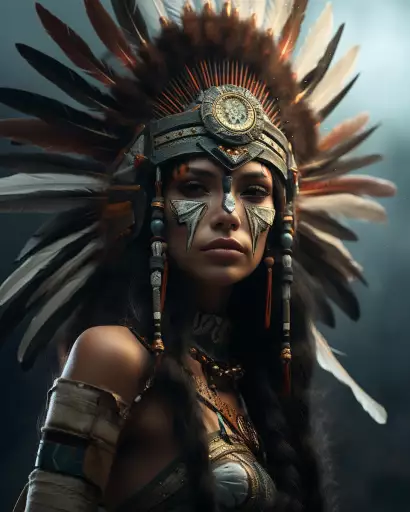Explore the Best AI Image Gallery

Pixels & Perceptions: AI-Generated Images and the Evolving Art Landscape
The art world is witnessing a seismic shift with the emergence of AI-generated imagery. No longer confined to the realms of science fiction, artificial intelligence is now capable of producing stunningly realistic and imaginative visuals, blurring the lines between human creativity and machine ingenuity. This technological advancement has ignited a fervent debate, prompting us to re-evaluate the very definition of art, its creation, and its value in our increasingly digital world.
A New Canvas: The Potential of AI in Art
AI-powered image generation tools offer artists and designers a powerful new set of capabilities. They can:
- Generate novel concepts: Overcoming creative blocks by producing unexpected visuals that spark inspiration.
- Rapidly iterate designs: Experimenting with various aesthetics and styles at an accelerated pace, streamlining the design process.
- Personalize artwork: Creating unique pieces tailored to individual preferences and tastes.
- Enhance accessibility: Empowering individuals with limited artistic skills to express themselves creatively.
Applications Across Industries
The impact of AI-generated images extends far beyond the realm of fine art. Its applications are rapidly expanding across diverse industries:
- Marketing and Advertising: Creating eye-catching visuals for campaigns, social media, and product packaging.
- Entertainment: Generating concept art, backgrounds, and even character designs for films, games, and virtual reality experiences.
- Education: Providing interactive learning tools and visualizations to enhance understanding of complex concepts.
- Architecture and Design: Conceptualizing building designs, interiors, and urban landscapes.
Ethical Considerations: Navigating Uncharted Territory
While AI-generated images hold immense potential, their rise also raises crucial ethical considerations:
- Copyright and Ownership: Who owns the copyright to AI-generated art? The creator of the algorithm, the user who inputs the prompts, or the AI itself?
- Bias and Representation: AI algorithms are trained on vast datasets, which can reflect existing societal biases. This can result in the generation of images that perpetuate harmful stereotypes or lack diversity.
- Authenticity and Deception: The ability to create hyperrealistic images raises concerns about the potential for misuse, such as creating deepfakes for disinformation or manipulation.
Shaping the Future: A Collaborative Landscape
The future of AI-generated images lies in a collaborative approach that embraces both its transformative power and ethical challenges:
- Developing Ethical Guidelines: Establishing clear guidelines and regulations for the development and use of AI art tools.
- Promoting Transparency and Accountability: Ensuring that users are aware of how AI algorithms work and the potential biases they may exhibit.
- Fostering Interdisciplinary Dialogue: Encouraging conversations between artists, technologists, ethicists, and policymakers to shape responsible innovation.
- Education and Awareness: Raising public awareness about the capabilities and limitations of AI-generated imagery.
AI-generated images are undoubtedly transforming the art landscape, offering both exciting possibilities and complex challenges. By navigating these uncharted waters with thoughtful consideration and collaboration, we can harness the power of AI to enrich creative expression, foster innovation, and push the boundaries of what is possible.








![**Representation: A teenager smiling while thinking about a friendly dog, a comic-style thought bubble with a friendly dog inside. Graphic style: Line drawing, cartoon style, influenced by Franco-Belgian comics, thick black lines, simplified design, vector, black and white only, in the style of Keith Haring or the French comic strip "Alinéa". [IMPORTANT]: A single continuous line extending from one side of the image to the other, minimalist, strong outlines, line drawing, without lifting the hand, ultra-simplified, no shading, entirely white image, drawing created in the center of a sheet of paper. --ar 16:5** - <@627984126871470085> (fast)](https://images.ai-img.art/thumbnails/150/6fc850f638e3dee0c4b121acecad2c8419e02bdeac7f871d625f1003c1c3abe1.webp)


![**Representation: A dog acting as a private tutor to a child. The dog holds a ruler in its paw and stands at the blackboard to explain a dog diagram to the child. Graphic style: Line drawing, cartoon style, influenced by Franco-Belgian comics, thick black lines, simplified design, vector, black and white only, in the style of Keith Haring or the French comic strip "Alinéa". [IMPORTANT]: A single continuous line extending from one side of the image to the other, minimalist, strong outlines, line drawing, without lifting the hand, ultra-simplified, no shading, entirely white image, drawing created in the center of a sheet of paper. --ar 16:5** - <@627984126871470085> (fast)](https://images.ai-img.art/thumbnails/150/7a854648a81e51241dcca8d24dd6e3bfcf07ad1df51baf401c9b729f4cf411fa.webp)

















](https://images.ai-img.art/thumbnails/150/9d51c5e673b4f2068b7b01abc35425a06f173b76303adf9ad29ca14302c25b18.webp)







![**Representation: A dog acting as a private tutor to a child. The dog holds a ruler in its paw and stands at the blackboard to explain a dog diagram to the child. Graphic style: Line drawing, cartoon style, influenced by Franco-Belgian comics, thick black lines, simplified design, vector, black and white only, in the style of Keith Haring or the French comic strip "Alinéa". [IMPORTANT]: A single continuous line extending from one side of the image to the other, minimalist, strong outlines, line drawing, without lifting the hand, ultra-simplified, no shading, entirely white image, drawing created in the center of a sheet of paper. --ar 16:5** - Variations (Strong) by <@627984126871470085> (fast)](https://images.ai-img.art/thumbnails/150/f4e034998ccd869d8a061fd12017514fcd92210eb33d4222dc9b54716223f4dd.webp)




](https://images.ai-img.art/thumbnails/150/51c93500396faff4e7fa8b42bc68033067b16b2230e3496e95c482a581ff0fe9.webp)

](https://images.ai-img.art/thumbnails/150/157712d76865d557120f9baf988de3d0525225295a2789c89bf2c4a5a96a03d1.webp)